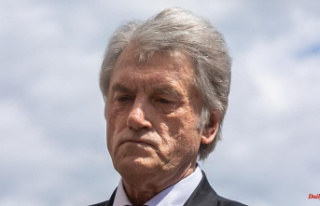An icon awaits right at the beginning of the journey in northern California: the Golden Gate Bridge. The bridge, completed in 1937, which connects San Francisco with Marin County on the other side of the bay, is always an experience, even for experienced visitors to the USA.
When completed, it was the tallest and longest suspension bridge in the world. She hasn't been for a long time. But it's still impressive to drive the 2.7 kilometers across the Pacific and see the city in the rear-view mirror.
So first stop: photos with bridge and skyline. Back in the car, Highway 101 tunnels, merging with Highway 1 here, before forking at the Stinson Beach exit. We follow Highway 1 toward the Pacific.
You quickly realize what you've gotten yourself into: the road is winding and the road will stay winding. And partly it leads directly along the cliffs. Curves, hairpin bends and hairpins require concentration – and they mean not going too fast.
"You have to take your time on this road," says Jeff Weiss, spokesman for the Caltrans Roads Authority. It's spectacular, but it's also very exposed in many places. As a result, parts of the road are regularly buried or break away during storms and heavy rainfall.
In some places it is even being moved further inland. "Erosion from rain and wind threatens the strait from above, the waves and the rising sea level from below," Weiss explains of the Gleason Beach Project between Bodega Bay and the Russian River, where the strait is currently up to 120 meters long for around half a mile being moved offshore for $26 million.
But as long as Highway 1 is where it is, travelers can enjoy the coast road and the numerous "Vista Points" along the way. High cliffs rise out of the Pacific, there are beaches with black and white sand, seals relax in the sun.
We stop at Sea Ranch. This place emerged in the 1960s, somewhere in the middle of nowhere between the dense forest and mountains on one side and the waves of the Pacific Ocean on the other. Distinctive wooden houses stand on a cliff, there is a post office and an office where land is sold. And brand new: a chic restaurant and a hip shop.
But actually, the Sea Ranch is a meeting place for everyone who lives in the area. There are mixed crochet circles as well as art exhibitions, baby groups and discussion groups.
During the corona pandemic, many people from the big cities have settled in this quieter part of California, says artist and gallery owner Maynard Hale Lyndon. His brother Donlyn was one of the architects of what the New York Times described as California's modernist utopia some sixty years ago, with the aim of making the world a better place. Through architecture that gave nature its space.
Apparently, the landscape has lost none of its charm since then. "And with the opportunity to work from anywhere, more young families are coming here again," says Lyndon.
Michael Stusser also had a great idea decades ago. "We wanted to create a completely new place," he says. A place where people can feel good. Wellness before the term even existed. He set up his life's work Osmosis on the Bohemian Highway. To get there, exit Highway 1 at Valley Ford.
Stusser spent many years in Japan and imported some ideas from the Far East to California. The result was what is now called a “retreat”, i.e. a place of retreat. A house that was built in the 1960s "and that we built back then so that it looks like it was 100 years older," says Stusser with a wink. But the external impression is deceptive.
Behind it is an oasis of calm including a bamboo forest, a manicured Feng Shui garden with a koi pond and a treatment house in the middle of the forest. But the most coveted of his offerings is a large wooden box on the ground floor of the house.
"Cedar Enzyme Bath" is the name of Stusser's pride. The guest sinks into a warm mixture of ground cedar wood and rice bran - enzymes that are produced during fermentation are said to help with numerous ailments and are good for the skin. Whatever the case, it smells nice, is nice and warm, and, according to Stusser, you can't get it anywhere else in North America.
There's another highway along the California coast. However, it is in the Pacific. Pretty much all kinds of big whales swim from north to south here – and back again. From Alaska to Mexico and Hawaii to have their children there. And back to Alaska to gorge on for the summer. Especially in spring, gray whales swim in both directions.
"We actually see whales here every day when we go out there," says Captain Tim Gillespie, who steers his fishing boat "Sea Hawk" out to sea from Fort Bragg. Not a tour for the faint of heart. Because the port exit to the Pacific is narrow and the water is violently in motion. But the hardships are forgotten immediately when the first fountains can be seen from the whales' blowholes.
A relic from the times of the timber industry has also been preserved in Fort Bragg: In order to be able to load the tree trunks of the redwoods, the red giants, tracks were built in many places. Trains no longer run north from San Francisco, but the Skunk Train still operates on these old tracks.
“Skunk” means skunk. That's what the old steam train used to be called, the stench of which announced it long before the noise. Today there are still idyllic tracks between the sequoia trees, on which you can ride in the historic train. Or under your own steam – with so-called rail bikes. They are powered by pedals like a bicycle. What sounds exhausting is not so bad: the four-wheelers are equipped with electric motors.
The further north you drive on Highway 1, the more prominent the typical trees in the area, the redwoods, become. They can be seen from San Francisco to Humboldt County just before the Oregon border.
Along the Avenue of the Giants, a winding road through the redwood forest, it is mostly quiet, only the wind can be heard. The Sequoia sempervirens, as the coast redwoods are called in botanical terminology, first branch out high up and form a coniferous canopy. And sometimes a branch falls on the road.
Then Justin Legge is over the moon. "Here, nature does what it wants," says the nature guide. "It doesn't happen that often anymore." Almost every day he's somewhere on the avenue in the woods, often with a group of stressed-out city dwellers to celebrate forest bathing with them. Embracing trees, some say derogatory.
"But that's not it," says Legge. After all, it has been scientifically proven that the forest is good for people. And the redwoods are very special. Especially when it gets hot in California in the summer, the climate in the forest is consistently pleasant. And the sequoias are just amazing.
The trees are unique, says Legge. But they are also divas. This species grows roughly from San Francisco to the Oregon border. However, not too close to the Pacific because the salt water would destroy them. They don't like it too hot either.
About 150 years ago, the huge trees made some people very rich. Whole forests were cut down to build with the wood: houses, furniture, even water tanks. However, says Legge, this red wood is not particularly suitable for building. Too soft.
Anyone who arrives at the Avenue of the Giants has already left Highway 1 behind - 30 miles (about 48 kilometers) before, at Leggett, it becomes Highway 101 again. But the road through the imposing forest remains winding. Curvy and adventurous.
Destination: Highway 1 runs from Dana Point near Los Angeles to Leggett in Mendocino County, where it becomes Highway 101. It is 418 miles or 673 kilometers from the Golden Gate Bridge to the transition to Oregon.
Arrival: Direct flights with Lufthansa, Delta and United from Frankfurt/Main and Munich to San Francisco.
Entry: Germans need a valid passport and must obtain an entry permit (Esta) online. Furthermore, a full Covid-19 vaccination must be proven. Visit the US Embassy website and the State Department for more information.
Travel time: California is a year-round destination. The summers are warm and dry, directly on the Pacific it can be foggy with large temperature differences to the inland. Winters are mild and it can rain.
Information: visitcalifornia.com
After the ground staff strike, Lufthansa is back to normal operations. But the next strike is already looming, this time by the pilots' union. What to do if the flight is cancelled? "If no replacement flight is provided, you can remedy the situation yourself," says Kay Rodegra, a lawyer specializing in travel law.
Source: WORLD












